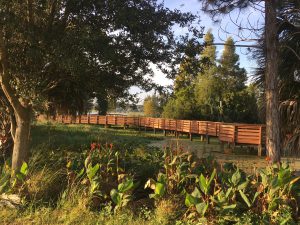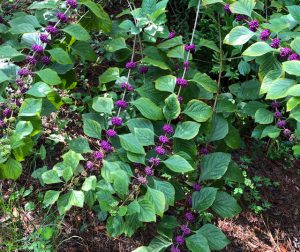Most gardeners everywhere enjoy the rewarding experience of being “grounded”, so to speak, by planting and maintaining beautiful garden spaces. And what better way to become grounded in our local environment than by including Florida’s native plants in our landscapes? The benefits of native plants are tremendous!
Beauty

Our area continues to experience tremendous population growth, and with the land-clearing loss of natural habitats, many newcomers have not witnessed the beauty found in our native plants. In fact, many longtime residents may be unfamiliar with our own native plants. Can you picture the following scenes?
…. early foggy winter mornings as the rising sun creates a show of sparkling dew on the fronds of a saw palmetto, or clinging to foliage tips of a native cedar tree…..
…. abundant clusters of deep purple berries on a beautyberry shrub…
…. Bright red berries on a native holly tree, enjoyed by visiting birds…
…. cheerful blossoms of Florida native wildflowers…
Function
Native plants designated for our Zone 9 climate are adapted to our growing conditions. When placed in the right spot (following the Florida-Friendly Landscaping™ principle of Right Plant, Right Place), they tend to grow and flourish with very little extra care. Less care means minimal to no supplemental fertilizers and pesticides. Because they are adapted to our climate, there is no fear of random winter freezes; established native plants in our landscapes are hardy and laugh in the face of dropping temperatures! It is important to remember though, that some native plants die back naturally in the cooler months, but never fear—they will return in the spring!
Versatility
There are native plants for every landscape! From very large landscapes to smaller urban yards; to foundation plantings of businesses, there is a native plant variety that can supply the look of a “true” central Florida landscape! There are native plants for sun or shade, and soils that are dry or wet. Even residents of apartments and townhouses can enjoy native plants, as many thrive in containers!
Improving our Planet!
There is a growing awareness of the strains upon our environment that can be improved by even the smallest introduction of native plants. The beginning act of reducing a high-maintenance area and creating a bed of native plants provides cooling shade and production of oxygen. Landscapes with native plants filter rainfall and reduce pollution from stormwater runoff. Finally, native trees, shrubs and wildflowers provide year-round shelter and nourishment for birds, pollinators, and other small wildlife.
Native plants create a “living” landscape or garden. The joys of seeing the first hummingbird, bee, or butterfly in your own landscape can bring a thrill as you witness nature first-hand, and know your plants are supplying a natural haven for these little creatures!
This article was written by Master Gardener Volunteer Molly Griner under supervision of the Master Gardener Volunteer Coordinator and Residential Horticulture Extension Agent Anne Yasalonis.
Resources in this article:
For more information, contact UF/IFAS Extension Polk County at (863) 519-1041 or visit us online at http://sfyl.ifas.ufl.edu/polk. The Plant Clinic is open Monday-Friday, 9:00 am-4:00 pm to answer your gardening and landscaping questions. Give us a call or email us at polkmg@ifas.ufl.edu.
If you are not in Polk County, Contact your local UF/IFAS Extension Master Gardener Volunteer Plant Clinic.
The Florida Master Gardener Volunteer Program is a volunteer-driven program that benefits UF/IFAS Extension and the citizens of Florida. The program extends the vision of the University of Florida/Institute of Food and Agricultural Sciences, all the while protecting and sustaining natural resources and environmental systems, enhancing the development of human resources, and improving the quality of human life through the development of knowledge in agricultural, human and natural resources and making that knowledge accessible.
An Equal Opportunity Institution.
Source: UF/IFAS Pest Alert
Note: All images and contents are the property of UF/IFAS.



